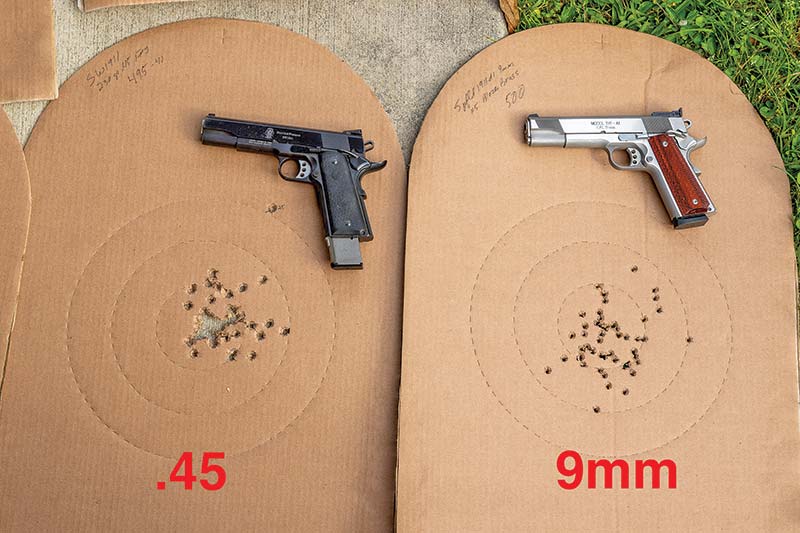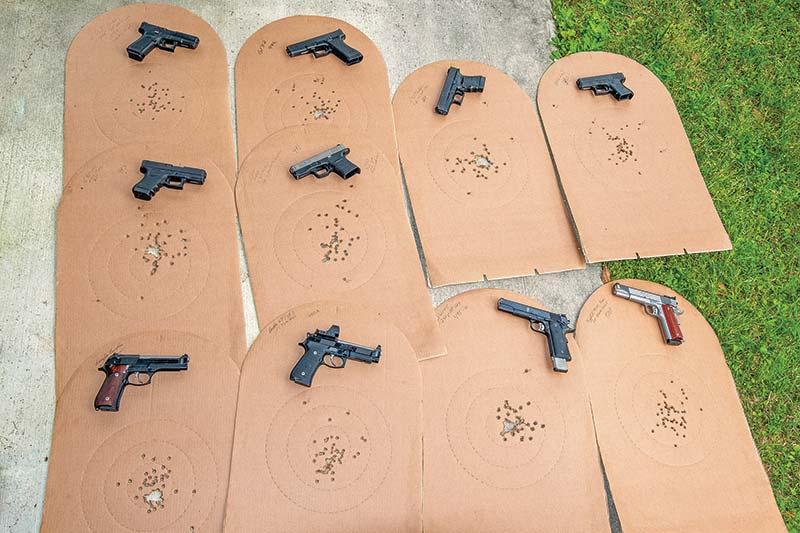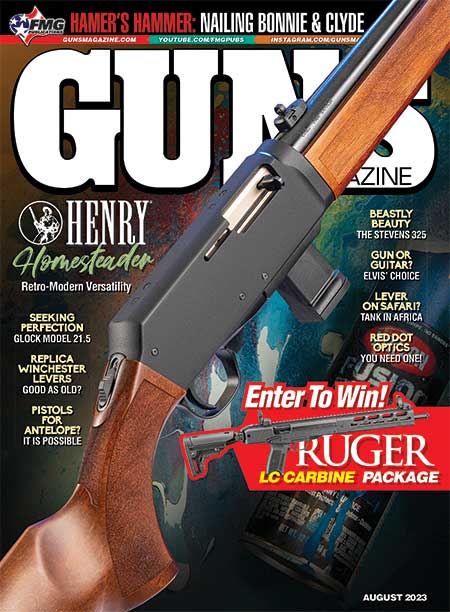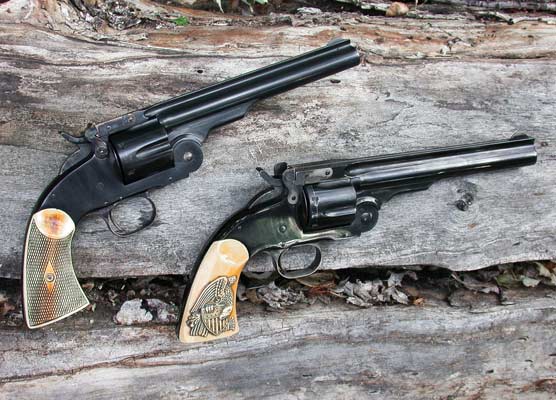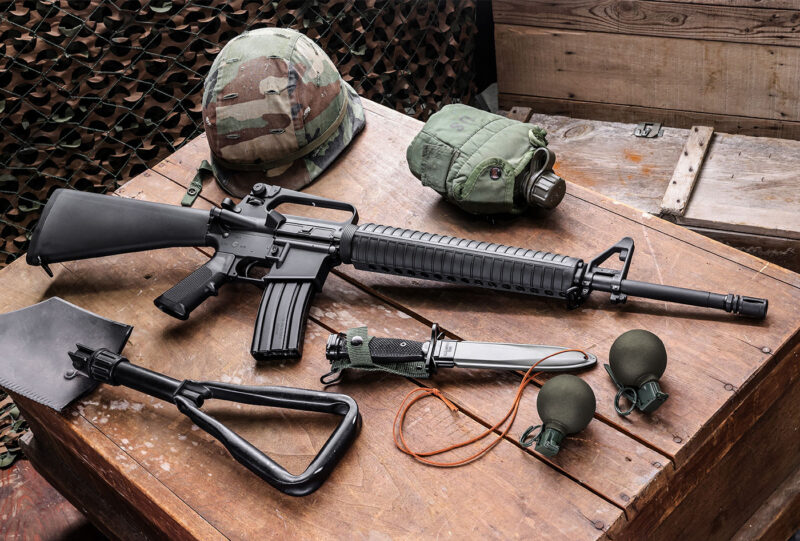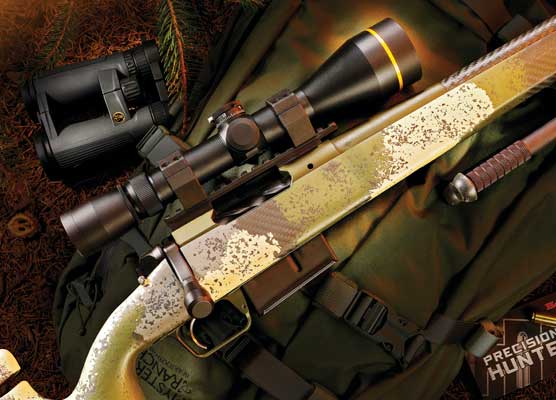Learning Reinforcement
10 Pistols + 500 Rounds = Insight
Recently in this column we’ve looked at shooting established drills to get a sense of how well we’re performing. By regularly shooting one or more of the same drills, you can better track skill improvement or deterioration. A drill — a specific course of fire — is also a good way to see whether the gun we really like, likes us back compared to others. The proof is in the shooting, not the “feelz.”
I took a simple two-hand standing test, the “gallery” or “indoor” course from the GLOCK Sport Shooting Federation (GSSF). This involves 50 rounds, all shot within specific time frames, at ranges from 5 to 25 yards. The target is the tan D-1 developed by the late Ray Chapman, for the Bianchi Cup. It remains standard today in that discipline, now known as NRA Action Pistol, and GSSF. It is all shot two-hand standing with a drawn gun from low ready, which gives a good baseline comparison of “shootability.” Outdoor matches count the 10″ circle as 10 points, the 13″ as 9, and the rest as 8; I used the more demanding indoor scoring of 10, 8 and 5. Five rounds each are fired at 7 and 15 yards, then 1-round strings at 5, 7 and 15, all in 15-second time limits. The last 10 shots are from 25 yards in 30 seconds.
I ran it with 10 different pistols, 500 rounds. As the late, great instructor Pat Rogers was known to say, “Learning occurred,” or at least, reinforcement of the learning experience.
Learning Points
Trigger pull weight — Does a light pull make you a much better shot? However, “easier to shoot intentionally” has to balance against “easier to shoot unintentionally” and cases such as NY v. Frank Magliato and Santibanes v. Tomball show us a too-easy trigger can be problematic. I took three subcompact GLOCKs in .45 Auto through the course, all with full power 230-grain hardball. Using the 3.5- to 4.5-lb. connector GLOCK pretty much forbids serious business, as opposed to competition shooting, a G30SF (Short Frame) shot only 483. With a RoBar Custom G30S (Slim, with lighter slide) and standard 5.5-lb. trigger, I got 491. I shot another 491 with my old Tarnhelm grip-trimmed G30 with the 8-lb. combination of a 5.5-lb. connector with the NY-1 trigger spring module.
In 9mm, my old Gen2 GLOCK 17 with 3.5-lb. trigger — long a dedicated match gun — turned in a 492. A Gen5 G19, whose trigger pull is in the 6-lb. range, was “top GLOCK” of the test with a 498. So much for conventional wisdom …
Striker v. TDA v. SAO — Traditional double-action auto design was represented by a couple of Beretta 92 9mms tuned by Ernest Langdon. They each turned in a 498/500. The two single-action autos delivered a 498 and the only 500 of the test. With striker-fired GLOCKs, the high score was a 498 with the box-stock G19 Gen5, in 9mm like the Berettas, which I had been carrying that week. The overall average was 491 (98.2%) for the several GLOCKs in 9mm and .45, 498 (99.6%) for the TDAs and 497.5 (99.5%) for the two 1911s (one in each caliber). A Smith & Wesson SW1911 with a Wilson Combat 10-round .45 magazine delivered 495 (one bad hit, darn it!), while a Springfield Armory match grade 1911A1 9mm, also with Wilson 10-round mags, gave the only 100% 500 score of the test.
Iron sights v. carry optics — Breaking a tie with center-X hits, my old Langdon Custom Beretta 92 with Novak iron sights scored 498 with 41X. My relatively new Langdon Custom LTT 92 with Trijicon SRO optic was also 498 at the end, while 43X and most of the hits outside the X-ring came at 25 yards. I’ve been shooting irons a whole lot longer than optics and this probably had something to do with it.
9mm v. .45 — There’s a lot to debate, but the 495 of the 1911 .45 against the 500 of the 1911 9mm (trigger pulls were about the same, in 4-lb. range) wasn’t a lot of difference. Per shot with comparable loads, the .45 will make a bigger wound channel, but the 9mm has two more rounds, and the .45’s overall average 490.00 (98%) versus 9mms’ 495.17 (99%) difference in score ain’t a lot. On the other hand, with faster shooting than in the GSSF course, a .45’s greater recoil could slow some shooters down more.
Sight Radius — The highest scoring guns had 4.0″ to 5″ barrels. The shortest gun, a G26 subcompact with 3.6″ barrel gave me 487, the lowest 9mm score of the test.
Bottom Line
Habituation gets a vote. Familiarity with a given trigger pull turned out to be more important than weight or length of pull. Consistently solid stance, firm grip, and distributed trigger pressure worked well across the different platforms. You want to do your own testing. I would go beyond the GSSF test here and include one-hand/“weak-hand” only, speed reloads and a time-into-score course of fire. All will be positive learning experiences, if only to reinforce what you already knew.
